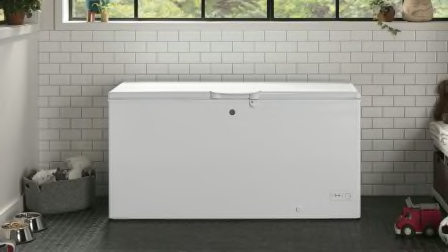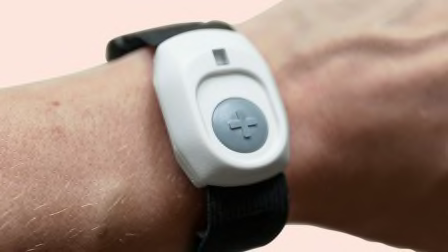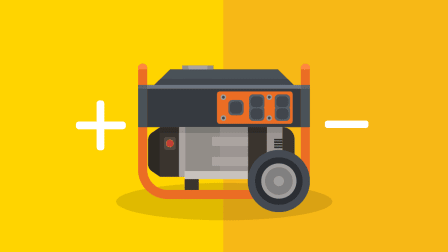5 Ways to Stay Warm During a Winter Power Outage
When you shop through retailer links on our site, we may earn affiliate commissions. 100% of the fees we collect are used to support our nonprofit mission. Learn more.

Winter storms leave thousands of Americans without power each year, but there are several steps you can take to stay warm and safe.
1. If You Can, Get a Generator
Even if you’ve already lost power, it’s not too late to look for a portable generator. Sales always spike during weather emergencies, but it’s still worth trying.
Some major retailers have told CR that they’re able to reallocate the supply of generators to affected areas in as little as a day or two. A good strategy is to show up early at a store to grab one before they’re sold out.
If you’re fortunate enough to find a portable generator, use our guide to get it up and running quickly and safely. Once the outage is over, hire an electrician to install a transfer switch or interlock device so that the generator can power entire circuits in your home, which is both safer and more helpful.
If you can’t find a portable generator at a home center or power equipment dealer, try looking for a recreational generator at places like Dick’s Sporting Goods and Walmart, or even at a local RV or boat dealership.
These smaller generators aren’t really designed for power outages, but their output of 1,800 to 2,000 watts is still enough to power a large space heater and charge cell phones, which may be enough to get you through an outage.


2. Stay in a Southern-Facing Room
Even without heat, on a sunny day in particular you can maximize your warmth inside by gathering in a room with southern-facing windows.
Use a compass app on your phone or a real compass if you have one to find a room that fits that bill. Then keep your family in this shared space as much as possible. The collective heat generated by your bodies will also keep the space warmer.
3. Seal Window and Door Leaks
Keeping warm air in and cold air out is crucial, and the process is the same for both. Seal leaks around windows and doors using caulk or weather stripping if you can.
If you can’t get those materials, look for duct tape and clear plastic sheeting. (Clear lets sunlight in through the windows, which helps warm the room.) If you can’t find regular plastic sheeting, try the paint aisle at a home center, which often has clear plastic drop cloths.
For drafty doors, use draft guards. If you can’t find them, towels and blankets are fine.
Some leaks are obvious, while others aren’t. Look for subtle leaks using a stick of incense or a candle. Carefully move the candle or incense near problem spots like windows. If you see the flame flicker or smoke from the incense quickly disappear through a window, it’s a sign that you have a leak.
4. Use a Fireplace or Another Heat Source
If you’re fortunate enough to have a well-maintained wood stove, use it. Never go to bed with a fire burning, however, and keep the area immediately around the fireplace or stove clear of any flammable materials. Keep kids and pets away, too.
If you don’t have a fireplace, consider using a portable propane heater. But make sure you use it properly.
“Consumer Reports only recommends using a portable propane heater designed for indoor use in an emergency,” says John Galeotafiore, CR’s associate director of product testing. “And you should only use these tools if you’re able to follow crucial safety instructions.”
In addition to the directions in the owner’s manual, these heaters should be used only on a hard, fireproof surface and in an area free of kids, pets, and flammable materials.
Make sure that you have working smoke and carbon monoxide alarms on every level of your house and that you’ve selected a heater that’s suitable for indoor use.
These heaters produce carbon monoxide, so you’ll need to keep a window open a small amount to allow for safe ventilation. Check the owner’s manual for specifics, which will vary depending on the output of the heater.
Never leave a portable heater running unattended or during any period when you are sleeping.
5. Camp Out Indoors
If you can’t get your hands on a generator or heater, consider camping out inside your home.
A tent and sleeping bags can help keep you and any family members warm and safe, particularly through the night when temperatures tend to drop.
Hypothermia can be a concern at any age, but particularly for young children and older adults, according to the Cleveland Clinic. Dress in loose layers, as opposed to one heavy layer, and make sure to stay dry. Even sweat from exercising can raise your risk of developing hypothermia.
Best Portable Generators to Power Your Home
These workhorses provide 7,000 to more than 8,000 watts of power—but they usually weigh upward of 200 pounds. They’re what you want to use to power most or all of your home’s essentials during a prolonged outage. If you get one of these generators, you’ll probably want to have an electrician install a transfer switch, which allows you to plug the generator into your electrical panel and power hardwired appliances like a water heater or a well pump. Prices for these models currently range from just under $1,000 to over $2,000.
Best Portable Generators for Small Houses
These midsized generators provide 2,500 to 4,900-plus watts of power and weigh about 80 to 180 pounds. They pack plenty of power for a boat, an RV, or a camper, or they can power a few household essentials using heavy-duty extension cords. Note both the price and the power output when you’re shopping; inverter models that deliver modest amounts of power can be pricier than higher-output traditional portables. Prices range quite widely, from around $400 to $2,400.




















